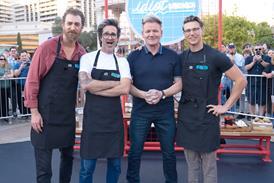At this stage, he argues, it's less about selecting kit and more about documenting current and future work processes.
Remember when Panasonic's D3 format came out? Remember when IBC was in Brighton? You may also remember that some people forecasted that D3 would be the last tape format that the BBC would buy. Well it's now 2005 and guess what - the BBC, and other broadcasters, are still buying tape machines. To be fair the volume of sales is significantly reduced but that panacea of tapeless production is still some way off.
Perhaps we need to look more closely at what we mean by tapeless production as I suspect it means different things to different people. Back in the early 1990s, "tapeless" possibly meant a replacement video recorder that used an array of computer hard drives rather than tape. Then again there were some who were truly switched on to the digital revolution and spotted an application for this new technology that was more about liberating the creative process than the technology itself. The real goal for tapeless production is an integrated end-to-end solution.
For many years our industry has been driven by products rather than process, with perhaps one notable exception, the Quantel Paintbox. Paintbox's success was down to Quantel understanding what a graphics designer's existing process was, the resources needed to execute that process and then building a product around that brief.
How often have we (programme-makers) had to change our process to work around a new installation/piece of kit? We can't blame the manufacturers as I suspect we collectively gave them such a wide brief that in order to sell product and make a profit, they produced to the lowest common denominator. Let's also be very clear here - the purpose of a manufacturer is to make a profit. Public service broadcasters do their thing and manufacturers/businesses make a profit.
The production process
Do we really know the process that is used to produce content across different genres? Do we look for ways to streamline our existing process? Have we tried to map out a future process with tapeless at the heart? This for me is an area of work we need to sit down and continuously evaluate, for if we don't know our existing process and have never thought about our possible future process, then we will be stuck buying tape machines for years to come.
We must also ensure that when we move into the tapeless environment we don't simply map our old processes onto the new technology. Part of the move to tapeless is, for example, about not needing VHSs of all of your rushes. We need to consolidate all paperwork and allow more time and creative energy to be put into crafting the programme rather than working around a multitude of incompatible systems. Now is the time to really focus on how we want to work and the process we aspire to.
Metadata
Just so we are clear, metadata is information about information. It's the ISBN number on a book, it's the registration number on your car, it's a word that helps you find a particular shot on your rushes. Within a tapeless environment metadata is everything.
Pictures and sounds are now a collection of ones and noughts, a spreadsheet is made with the same ingredients and so is an email. Our goal is to acquire all our content digitally with embedded metadata. In the field we will record without tape onto computer hard drives with metadata from the camera, metadata via wireless/Bluetooth from the PA to the director. In the studio, content with relevant metadata would be recorded direct to the programme-maker's content server. The question is then - what metadata do you record, who does it and when and perhaps, most importantly, how does this help your process?
On a news shoot, you may only require your metadata to define "journalist", "story" and "contributor". On a drama it may include amongst other items - "weather", "camera serial number" and "audio sample rate". The metadata should be for you to define so as to fit into your process. Remember the old adage about computers - "rubbish in equals rubbish out"? The same is true of metadata so work hard on getting relevant high-quality data into your tapeless environment.
Storyboarding
All content is storyboarded in some fashion, it may be "on the fly" in the cameraman's head while filming a live single camera action event, it may be beautifully crafted still images that are works of art in their own right.
Whereas historically storyboarding has been associated with pre-production, within a tapeless environment it is the heart of every stage of the production process. All content is about storytelling and what better way of achieving this than motion storyboarding? That's accessing your rushes, clipping up and ordering to formulate the essential elements within your story. Ideally we need that process in the office environment on a standard PC/Mac. It's also essential that all users have simultaneous access to all the relevant rushes/archive for that production.
At this point high-quality metadata transforms the process as you can search across metadata fields to find a - "MCU", "tiger" or even "sunset + buffalo". The results are returned within a second or two and you simply select and play.
At this juncture we should take a moment to think about image quality. When creating our motion storyboard we need to assess if a particular clip is in focus and hence you may hear the term "focus quality". Technically focus quality needs to be very good.
Finishing
Ever tried colour correcting an image on your office TFT screen? Angle of view, ambient lighting and colour temp settings ensure that what you see is not what you print. Let's move away from the office to a dedicated finishing area - with decent monitors, decent speakers, proper controlled lighting, we have a chance to put some craft into our edit. Yes, that's correct, it's a fairly conventional edit suite except that we can pick up the "storyboarded sequence" and continue working toward a finished programme without having to re-digitise any rushes. The metadata tags are used to compile the timeline accessing the content that has already been ingested onto the server, either direct from studio or as a file transfer from location filming. Ingest once - now there's a real change in process.
Let's now focus on the openness of our tapeless environment. We need to use our existing edit skills and the flow of content and metadata (essence) should be transparent and bi-directional between our core tapeless backbone and any third party application that we may wish to use. The edit station accesses the essence over a network (streaming) and all edits are tags within the metadata. So rather than doing a digi cut (record to tape), where the content exists on your local desktop editor's hard drive, cut programmes can be played out from the content server in real time using the metadata edit tags that you inserted on your edit station.
Conclusion
So you still want to go tapeless? Then start by understanding the detail of your existing process and looking at what you ideally wish to achieve in the future. While it's always difficult to totally map a future process it's a good idea to have a vision of where you're going. If not you will end up buying a product rather than a solution to your process.
Tim Wallbank on the planet earth tapeless pilot project
For the past year there has been a "pilot" tapeless project running within the Natural History Unit at BBC Bristol. I've been lucky enough to have delivered a significant amount of training to production, post-production and IT staff at the Whiteladies Road site.
BBC Bristol was chosen for this pilot as the original concept was born there many years ago. That's not the concept of tapeless, rather a specific implementation of tapeless production called "Project Mercury".
There are 26 users on the Bristol system with 1,000 hours of fast, resilient storage. All rushes are ingested by a post-production operator and are then available for the production team to log, storyboard and so on.
At ingest, duplicate feeds are encoded at different quality rates, but all stored on the content server with matching metadata. There is a broadcast stored format (BSF) encoded at about 26Mbits, a "focus quality" desktop editable format (DEF) encoded at about 13Mbits and various other lower data rate feeds. The idea is to use the DEF at the desktop and then use the BSF for outgest (playout). The clever bit is that the metadata tracks across all formats, so as the BSF is only needed for playout, it can be kept on a cheaper content server (nearline) while the DEF is used to create the storyboard. When required for playout the BSF is referenced using the common metadata. In the future the idea is to access a Windows Media format across the internet, but as the metadata tracks all formats, edit points marked in your hotel room can be used to play out the BSF. How about that for a change of process?!
As an approach, the changes have been readily accepted within the production team and successfully used to speed up the production process. Alistair Fothergill, executive producer on Planet Earth, has highlighted that it now takes three weeks to do a rough cut of a 50-minute programme where previously it took six weeks.
Producers can now view rushes as video files on their laptop in the field. The footage is from previously ingested rushes material that may be used prior/post to the material the producer is now filming. All prepared on the producer's desktop PC in their office in Bristol.
Another area that is a change in our existing process is that all producers can see all rushes and all storyboard sequences relating to the Planet Earth production at their desktop and a work area can be created containing, say, this week's best shots or a co-production work area to show the co-producers. Again, all done at the desktop.


























No comments yet